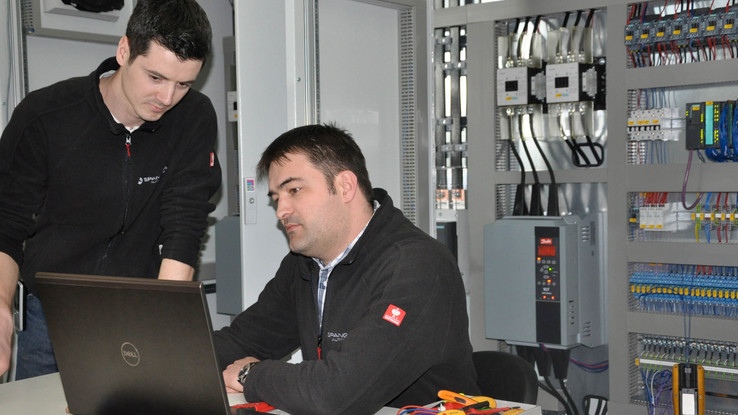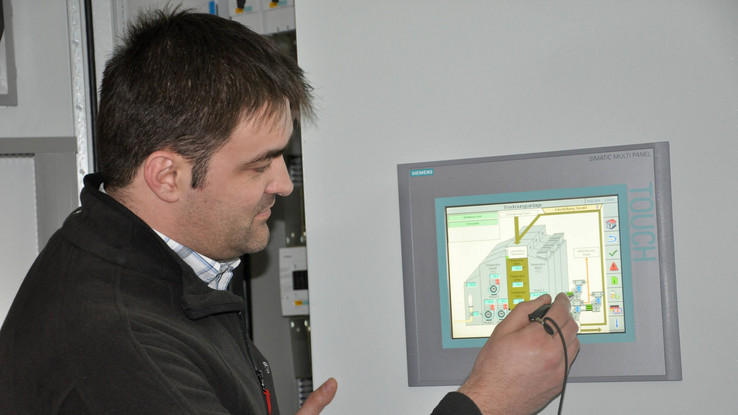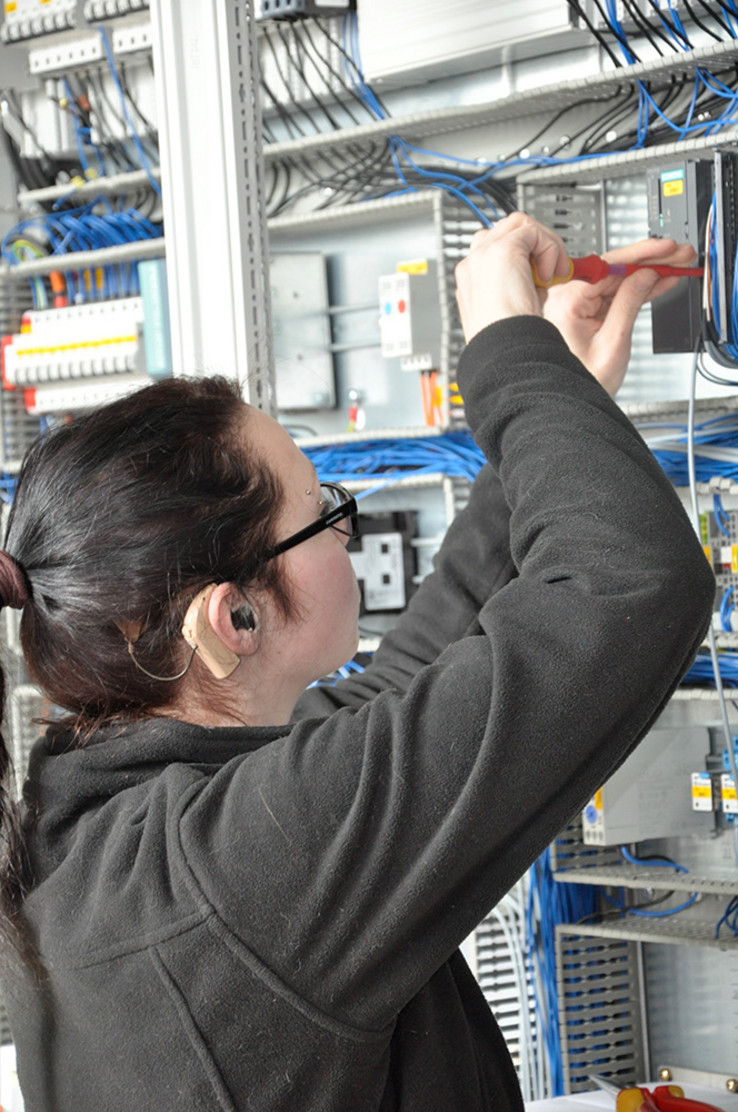Schematic at the push of a button
Spangler Automation plans and manufactures electrical automation solutions for complex plants

Every electrical plant that Spangler plans, builds and programmes has its own character. This is why the company works with an engineering platform, which can be used consistently. Managing Director H. Graspointner (left) and R. Meier.
Picture: Spangler
Spangler Automation plans and manufactures electrical automation solutions for complex plants and is specialised in unique plants worldwide. There are no standard solutions, but Spangler requires several standards for this purpose - which can only be managed using a continuous engineering platform. A discussion with the Managing Director Helmut Graspointner, and Rainer Meier, who is responsible for the software platform.
"Demanding tasks require platform-orientated engineering." Managing Director Helmut Graspointner is convinced of this "firstly because our customers' demands are rising, and secondly because the plants are becoming increasingly complex and the provisions more extensive. The throughput times are also decreasing." Helmut Graspointner manages the high-tech family business together with his sister Hannelore Spangler and his niece Tina Lambert, which was established in 1981 by Hannelore and Franz Spangler in Töging in the picturesque Altmühl valley.
When an automation engineer automates
It is actually only logical for an automation engineer to automate within their company: "Every automated work step lowers costs and improves quality. All in all, this results in a competitive advantage, which we in turn pass on to our customers", says Graspointner, explaining the principle by which this company acts. And as the growth figures, the employee development and the references suggest, it does this with great success. Spangler carries out electrical planning and control cabinet build for the packaging industry and for environmental engineering with biogas plants, drinking and waste water treatment. In the automotive industry, this includes battery or transmission test benches, which Spangler automates as well as large filter plants in the pharmaceutical industry. Spangler also provides tunnel drilling machines for the construction industry and electrical automation for the agriculture of the partners. A grain management system in Azerbaijan is currently on the order list as a major project, for example. The plant ensures that grain such as maize and soya is placed in stock at the right time directly following the harvest, whilst other batches are discharged at the same time - and are hence managed on the way to the next processing steps. Everything just in time! Customer-specific solutions are the norm for this wide range of industries. Every electrical plant that Spangler plans, builds and programmes has its own character. This is why the company works with an engineering platform, which can be used consistently – from the design, the PLC programming, the production and the service to practically all of the workstations for the company's 130 employees. The electrical documentation - consistently designed in EPLAN - is also processed customer-specifically.
An appropriate engineering solution
One question which continuously arises in the planning and development of electrical plants in day-to-day work is that of the correct standard, which also makes solutions possible that are by no means standardised. The plant for placing grain in stock in Azerbaijan is just one example of the unique projects of Spangler Automation. "At EPLAN , we have found the feasibility of a given standard through a good engineering solution", says Graspointner. "Ultimately, the solutions must be equally suitable for the diverse requirements of the machine engineers in the various industries." Like every good platform, it must be individually expandable. The automation engineers have drawn up their own practical solutions together with EPLAN . One of them is the Spangler Translate System. All languages are incorporated with this since they are indispensable in international business today. "Each one of our customers wishes to work in the language in which they can best communicate", believes Rainer Meier. He is responsible for the optimum use of the engineering platform at Spangler. As coordinator of the EPLAN project, he pulls all the strings.
Perfect data management
A second supplementary tool for the EPLAN engineering system is the 'Spangler Documentation System'. The ever-increasing quality standards for documents are stored there. The system ensures that the entire documentation remains transparent. Last but not least, the information should be able to be retrieved by all those involved at any time. "We have stored operating instructions from the component manufacturer online so that they are always kept ready for retrieval by us internally or by the customer externally. Together with the PDF of the circuit diagram, the data sheets can be easily downloaded via weblink", says Rainer Meier describing the supplementary tool responsible for the documentation. "Customers are hence kept up-to-date with the latest information, whilst saving obsolete paper folders."

When a control cabinet is set up, the internal system consistency plays a particularly important role. Since all those involved in the project know what the next process step is.
Picture: Spangler

Consistency decides the race for the right engineering platform. Everybody profits from the consistent platform. Since all data is managed centrally, all employees and customers can access it and work with it.
Picture: Spangler
The blessing of the interfaces
Sometimes it's the small things that make the electrical construction in complex customer plants easier for the Spangler experts: "When standards are organised via value tables and sub-domains are automated via the script technology", describes Meier, specifying the Spangler spare and wear parts list, which gives the customer important information, as another small but fine feature. Thanks to the open API interface of the engineering platform, Spangler has collocated several small tools and automates the recurring activities. 'The whole is more than the sum of its parts', since more is expected from the engineering platform used today than from its predecessor. "That was only a construction program for the constructing engineers. Sales and production employees had no contact with it", explains Helmut Graspointner. Today, those responsible attach importance to everything relating to construction and engineering being transparent for the whole team at all times. Every employee can access the parts management of EPLAN and extract its information. This makes EPLAN the right system in the IT landscape of the automation engineer. The administration department uses this to obtain information about customs tariff numbers and the country of origin in order to compile customs documents or delivery notes. Furthermore, technical information and setting parameters for commissioning a system are not some kind of 'arcane knowledge' that only the construction engineers possess. The open and expandable interfaces of the platform provide transparency and more access options for customers and employees.
The choice of engineering system
The interfaces are one of the key factors that led to the engineering solution of EPLAN being chosen in 2008. "Several systems were in the benchmark at the time", reflects Graspointner. "We have examined them carefully, starting with the market acceptance of the respective software, then moving on to the organisation of foreign languages and, eventually, handling. We also looked into the issue of how the systems solve the handling of various standards and provisions." Some key criteria also included examination into the central parts management and the intuitive handling of the software. "In other words, the software thinks along with you", says Graspointner, explaining the intelligent software. "Since every mouse click saved also saves overall costs. Errors are thereby prevented." Another request was to construct control cabinets to scale, which is possible in the 3D world with the current EPLAN Pro Panel. "The management of macros and the open and expandable interfaces, which interlink new auxiliary tools and existing systems, are also key advantages of the EPLAN Platform", says administrator Rainer Meier.

Picture: Spangler
Consistency decides the race
"But the most important advantage is clearly the consistency", stresses Meier and explains why everybody profits from the consistent platform: "Since all data is managed centrally, all employees and customers can access it and work with it." When a control cabinet is set up, the internal system consistency plays a particularly important role. "Since everyone knows what the next process step is". All of the drilling and milling data is brought into production via the company network for this purpose. "Our colleagues can automatically generate everything relating to labelling and marking", says Meier with pleasure in talking about the advantages. The customer can access the data sheets online. For projects with large data volumes, he looks at the data via the FTP server. "For 3D images and large data volumes, we can provide them with the circuit diagram via the Spangler-File-Portal using the FTP server", explains Meier. Programming will also be possible on this basis in future. "Plans are also already underway for organising and standardising the PLC programming via the engineering platform.", says Helmut Graspointner and refers to the most important thing: For a platform, it is always important that all data is standardised for internal or external use in such a way that anyone can access it and its reuse is ensured." The EPLAN Data Portal provides more data consistency. "We use the Data Portal, but would like to use it more often because the data portal is reliant on external cooperation", says the Spangler Managing Director and calls on the component manufacturers: "This tool is getting better and better and is becoming even more standardised the more data is added to the automation components. There is still considerable scope here." The Data Portal contains lots of information independent on the engagement of the component manufacturers. "This includes, for example, drilling patterns and rooting data", specifies Rainer Meier. "If this data is managed, this will later make the work for us and our customers much easier."
Macros from the same mould
Those who automate complete plants continuously rely on data sets, which are illustrated in macros. The question of the quality of a schematic macro has only one answer at Spangler - and that is standardisation. It is therefore strictly defined how macros should look like and who may generate them. This task is restricted to allocated employees and must be performed according to a certain specified scheme. "We only work on the control cabinet with these standardised macros. This is one of the demands of the consistent platform - otherwise it would simply become "full of garbage", says Graspointner. In his understanding, macros are the foundation for designing complex plants: "We incorporate experience here, which we previously collected at another point."
Everything new - the system introduction
No engineering system as good as this will be introduced to a company overnight. "Buying a system and getting started the next day… - that doesn't work", says Meier. "First you need capacities - as well as employees with lots of expertise, who are convinced", says Meier, specifying the requirements. "Apart from this, the employees must see the necessity from the sectors concerned." In the end, it is not only about data management because it is also important to reorganise working methods and workstations. "That is a complete invasion of the employees' personal matters", believes Graspointner. But customers are also affected. "We therefore present why we have switched to EPLAN at customer training sessions for example", says Graspointner. "But there we are practically opening doors which are already open if we explain to the customer how the circuit diagram should actually be read, and what auxiliary materials they can now revert to. "For this, we have not only called in the consulting team of EPLAN as a task force. The critical view from outside is always very helpful - since lots of advice has shown us what can be done better." But, in addition, it is never too late for an engineering system with constantly increasing function and benefits.
Time for visions
"Today, our macros are managed centrally, and we can already click together a certain scheme of our schematics via drag and drop", says Rainer Meier: What remains to be seen is the finished circuit diagram with the data of all power units at the press of a button. But Helmut Graspointner and Rainer Meier are already thinking about this with their partners.


